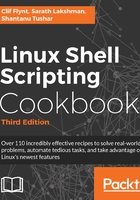
上QQ阅读APP看书,第一时间看更新
How to do it...
Pipes can be used with the subshell method for combining outputs of multiple commands.
- Let's start with combining two commands:
$ ls | cat -n > out.txt
The output of ls (the listing of the current directory) is passed to cat -n, which in turn prepends line numbers to the input received through stdin. The output is redirected to out.txt.
- Assign the output of a sequence of commands to a variable:
cmd_output=$(COMMANDS)
This is called the subshell method. Consider this example:
cmd_output=$(ls | cat -n)
echo $cmd_output
Another method, called back quotes (some people also refer to it as back tick) can also be used to store the command output:
cmd_output=`COMMANDS`
Consider this example:
cmd_output=`ls | cat -n`
echo $cmd_output
Back quote is different from the single-quote character. It is the character on the ~ button on the keyboard.